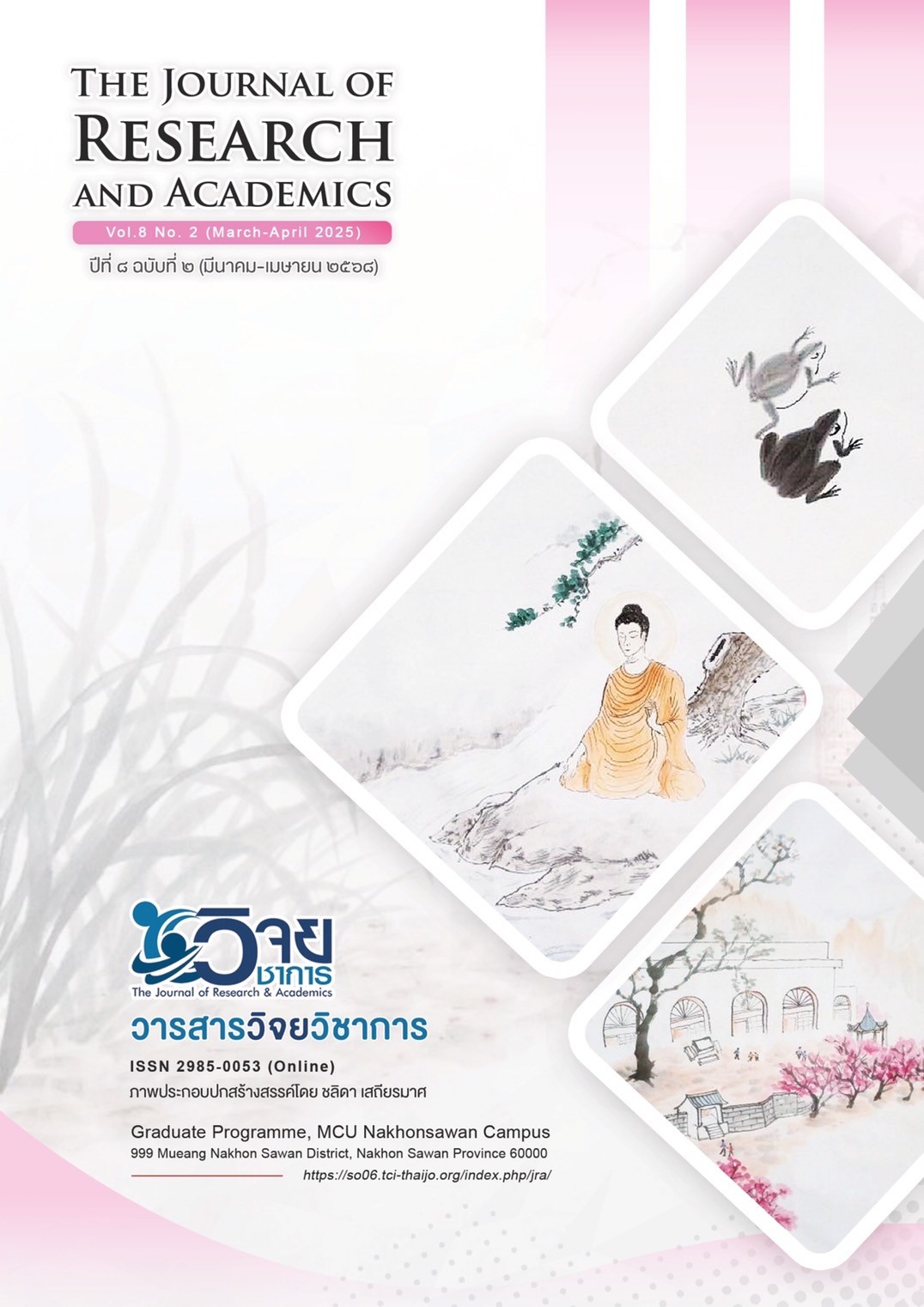การพัฒนาทักษะการฟังผ่านภาพยนตร์การ์ตูนภาษาอังกฤษและการตั้งคำถามตามลำดับขั้นของ Revised Bloom’s Taxonomy สำหรับนักเรียนระดับชั้นมัธยมศึกษาปีที่ 3
Main Article Content
บทคัดย่อ
บทความวิจัยนี้มีวัตถุประสงค์เพื่อศึกษาผลการประยุกต์ใช้ภาพยนตร์การ์ตูนภาษา อังกฤษ และคำถามตามลำดับขั้นของ Revised Bloom’s Taxonomy ที่พัฒนาทักษะการฟังของนักเรียนระดับชั้นมัธยมศึกษาตอนต้น ณ โรงเรียนชัยนาทพิทยาคม เป็นการวิจัยเชิงปริมาณ ประชากรที่ใช้ในการวิจัยครั้งนี้ คือ นักเรียนระดับชั้นมัธยมศึกษาปีที่ 3 จำนวน 190 คน วิชาเอกวิทยาศาสตร์-คณิตศาสตร์ และเรียนวิชาภาษาอังกฤษพื้นฐานในภาคเรียนที่ 2 ของปีการศึกษา 2562 กลุ่มตัวอย่าง คือ นักเรียนจำนวน 46 คน คัดเลือกด้วยวิธีแบบเจาะจง เครื่องมือที่ใช้ในการวิจัย ได้แก่ 1) แบบทดสอบการฟังก่อนเรียนและหลังเรียนโดยใช้การสร้างคำถามตามลำดับขั้นของ Revised Bloom’s Taxonomy เพื่อทดสอบพัฒนาการด้านทักษะการฟังของนักเรียน 2) ภาพยนตร์การ์ตูนภาษาอังกฤษ 3) แผนการสอน และ 4) แบบสอบถามความพึงพอใจของนักเรียนที่มีต่อกิจกรรมที่ออกแบบไว้ในแผนการสอน สถิติที่ใช้ในการวิจัย คือ คะแนนเฉลี่ย และส่วนเบี่ยงเบนมาตรฐาน ใช้คะแนนเฉลี่ยคำนวณคะแนนของนักเรียนแต่ละคน ค่าเบี่ยงเบนมาตรฐาน t-test dependent ผลการวิจัย พบว่า นักเรียนมีทักษะการฟังภาษาอังกฤษดีขึ้นอย่างมีนัยสำคัญทางสถิติที่ระดับ .05 หลังจากศึกษาภาพยนตร์การ์ตูน และมีระดับความพึงพอใจต่อกิจกรรมในห้องเรียนอยู่ในระดับพอใจมาก รวมทั้งได้ข้อสรุปว่าภาพยนตร์การ์ตูนภาษาอังกฤษสามารถนำมาใช้เป็นสื่อการสอนภาษาอังกฤษแบบทางเลือก ร่วมกับการเลือกใช้สื่อมัลติมีเดียที่เหมาะสม เพื่อส่งเสริมทักษะการฟังของนักเรียนชั้นมัธยมศึกษาตอนต้นต่อไป
Article Details

This work is licensed under a Creative Commons Attribution-NonCommercial-NoDerivatives 4.0 International License.
1. เนื้อหาและข้อมูลในบทความที่ลงพิมพ์กับวารสารวิจยวิชาการ ถือเป็นข้อคิดเห็น และความรับผิดชอบของผู้เขียนบทความโดยตรงซึ่งกองบรรณาธิการวารสารไม่จำเป็นต้องเห็นด้วย หรือร่วมรับผิดชอบใด ๆ
2. บทความ ข้อมูล เนื้อหา รูปภาพ ฯลฯ ที่ได้รับการตีพิมพ์ในวารสารวิจยวิชาการ ถือเป็นลิขสิทธิ์ของวารสารวิจยวิชาการ หากบุคคลหรือหน่วยงานใดต้องการนำทั้งหมดหรือส่วนหนึ่ง ส่วนใดไปเผยแพร่ต่อหรือเพื่อการกระทำการใด ๆ จะต้องได้รับอนุญาตเป็นลายลักษณ์อักษรจากวารสารวิจยวิชาการก่อนเท่านั้น
References
อมรศรี ชัยอาคม, มัสยา ราชวงษ์ และกรรณศาสตร์ แก้วแสนทิพย์. (2566). การจัดการเรียนการสอนเพื่อส่งเสริมการเรียนรู้ทักษะการฟัง-พูดภาษาอังกฤษ. วารสาร มจร อุบลปริทรรศน์, 8(2), 23-34.
Asmali, M. & Erarslan, A. (2021). The Effects of Videos on Listening Skill and Vocabulary in the Process of Language Learning. Mehmet Akif Ersoy Üniversitesi Eğitim Fakültesi Dergisi, (58), 601-623.
Bloom, B. S. & Krathwohl, D. R. (1956). Taxonomy of educational objectives; the classification of educational goals by a committee of college and university examiners. New York : Longmans, Green.
Chanaroke, U. & Niemprapan, L. (2020). The Current Issues of Teaching English in Thai Context. EAU Heritage Journal Social Science and Humanities, 10(2), 34-45.
Constructivist Teacher. (2021). How to Ask Questions Using Bloom's Taxonomy. Retrieved from https://inskru.com/idea/-MezCahG6ZChag5hM2uQ
Djabborova, F. O. (2020). Ways of developing listening skills of English learners in ESL and EFL classroom. European Journal of Research and Reflection in Educational Sciences, 8(10), 212-216.
Lasley, T. (2023). Bloom’s taxonomy. Encyclopedia Britannica. Retrieved from https://www.britannica.com/topic/Blooms-taxonomy
Likert, R. (1932). A technique for the measurement of attitudes. Archives of Psychology, 22(1), 5-55.
Maftuh, F., Mudofir, I., Aziz. M., Maaliah, E. & Fitriana, N. (2021). Using Authentic Materials to Improve Listening Comprehension in Esl Classroom. Proceedings of the First International Conference on Economics, Business and Social Humanities, ICONEBS 2020, November 4-5, 2020, Madiun, Indonesia DOI:10.4108/eai.4-11-2020.2304543
Mohideen, M. A. B. K. & Mohd, N. E. B. (2020). Watch’n Listen Effects of a Visual Approach on ESL Learner’ Listening Comprehension in an ESL Context. International Journal of Innovative Science and Research Technology, 5(7), 216-220. DOI:10.38124/IJISRT20JUL253
Nouthaphone, T. & Purbani, W. (2020). The effectiveness of using films in the teaching of listening to improve the student’s learning achievement and enhance the students’ learning motivation. LingTera, 7(1), 61-71.
Rahayu, M. S. & Rahayu, E. (2023). The Using of English Animation Movie to Improve Students’ Listening Achievement in the New Normal Era. Seltics Journal: Scope of English Language Teaching Literature and Linguistics, 6(1), 48-59. doi:org/10.46918/seltics.v6i1.1744
Yurko, N. & Styfanyshyn, I. (2020). Listening skills in learning a language: the importance, benefits and means of enhancement. Collective monographs, 38-46. DOI 10.36074/rodmmrfssn.ed-1.04
Zaim, M., Refnaldi, R. & Elfiona, E. (2020). Developing Mobile Based Authentic Listening Materials for Senior High School Students. Journal TA’DIB, 23(1), 1-10.

